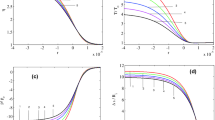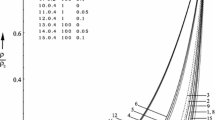Abstract
This paper presents simplified forms of jump relations for one dimensional shock waves propagating in a dusty gas. The dusty gas is assumed to be a mixture of a perfect gas and spherically small solid particles, in which solid particles are continuously distributed. The simplified jump relations for the pressure, the temperature, the density, the velocity of the mixture and the speed of sound have been derived in terms of the upstream Mach number. The expressions for the adiabatic compressibility of the mixture and the change-in-entropy across the shock front have also been derived in terms of the upstream Mach number. Further, the handy forms of shock jump relations have been obtained in terms of the initial volume fraction of small solid particles and the ratio of specific heats of the mixture, simultaneously for the two cases viz., (i) when the shock is weak and, (ii) when it is strong. The simplified shock jump relations reduce to the Rankine-Hugoniot conditions for shock waves in an ideal gas when the mass fraction (concentration) of solid particles in the mixture becomes zero. Finally, the effects due to the mass fraction of solid particles in the mixture, and the ratio of the density of solid particles to the initial density of the gas are studied on the pressure, the temperature, the density, the velocity of the mixture, the speed of sound, the adiabatic compressibility of the mixture and the change-in-entropy across the shock front. The results provided a clear picture of whether and how the presence of dust particles affects the flow field behind the shock front. The aim of this paper is to contribute to the understanding of how the shock waves behave in the gas-solid particle two-phase flows.












Similar content being viewed by others
References
Anand, R.K.: Phys. Scr. 86, 025401 (2012a)
Anand, R.K.: Astrophys. Space Sci. 342(2), 377 (2012b)
Ben-Dor, G.: Appl. Mech. Rev. 49(10), 141 (1996)
Carrier, G.F.: J. Fluid Mech. 4, 376 (1958)
Higashino, F., Suzuki, T.: Z. Naturforsch. 35 a, 1330 (1980)
Igra, O., Ben-Dor, G.: Appl. Mech. Rev. 41(11), 379 (1988)
Ivandaev, A.I., Kutushev, A.G., Nigmatulin, R.I.: Gasdynamics of multiphase media. Shock and detonation waves in gas-particle mixtures. In: In Advances in Science and Technology. Mechanics of Liquids and Gases, vol. 16, pp. 209–287. VINITI, Moscow (1981)
Kraiko, A.N., Nigmatulin, R.I., Starkov, V.K., Sternin, L.E.: Mechanics of multiphase media. In: Advances in Science and Technology. Hydromechanics, vol. 6, pp. 93–174. VINITI, Moscow (1972)
Kribel, A.R.: J. Basic Eng. 86(4), 655 (1964)
Marble, F.E.: Annu. Rev. Fluid Mech. 2, 397 (1970)
Miura, H., Glass, I.I.: Proc. R. Soc. A 397, 295 (1985)
Moelwyn-Hughes, E.A.: Physical Chemistry. Pergamon, London (1961)
Outa, E., Tajima, K., Morii, H.: Bull. JSME 19(130), 384 (1976)
Pai, S.I., Menon, S., Fan, Z.Q.: Int. J. Eng. Sci. 18, 1365 (1980)
Pai, S.I.: Two Phase Flow. Vieweg Tracts in Pure and Applied Physics, vol. 3, Chap. V. Vieweg, Braunschweig (1977)
Rudinger, G.: Phys. Fluids 7(5), 658 (1964)
Rudinger, G.: Fundamentals of Gas-Particle Flow. Elsevier, Amsterdam (1980)
Steiner, H., Hirschler, T.: Eur. J. Mech. B, Fluids 21, 371 (2002)
Acknowledgements
I acknowledge the support and encouragement of my wife, Nidhi during preparation of the paper.
Author information
Authors and Affiliations
Corresponding author
Appendix: Shock jump relations for ideal gas
Appendix: Shock jump relations for ideal gas
where M=U/a o and \(a_{o}^{2} = \gamma p_{o} / \rho_{o}\)
Jump relations for weak shocks in ideal gas
Jump relations for strong shocks in ideal gas
Rights and permissions
About this article
Cite this article
Anand, R.K. Shock jump relations for a dusty gas atmosphere. Astrophys Space Sci 349, 181–195 (2014). https://doi.org/10.1007/s10509-013-1638-4
Received:
Accepted:
Published:
Issue Date:
DOI: https://doi.org/10.1007/s10509-013-1638-4




